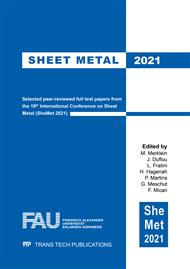p.189
p.195
p.201
p.209
p.217
p.227
p.234
p.242
p.250
Geometry Compensation Methods for Increasing the Accuracy of the SPIF Process
Abstract:
Despite years of supporting research, commercial use of the Single Point Incremental Forming process remains very limited. The promised flexibility and lack of specific tooling is contradicted by its highly complex deformation mechanics, resulting in a process that is easy to implement but where workpiece accuracy is very difficult to control. This paper looks at geometry compensation as a viable control strategy to increase the accuracy of produced workpieces. The input geometry of the process can be compensated using knowledge about the deformations occurring during production. The deviations between the nominal CAD geometry and the actual produced geometry can be calculated in a variety of different ways, thus directly influencing the compensation. Two different alignment methods and three deviation calculation methods are explained in detail. Six combined deviation calculation methods are used to generate compensated inputs, which are experimentally produced and compared to the uncompensated part. All different methods are able to noticeably improve the accuracy, with the production alignment and closest point deviation calculation achieving the best results
Info:
Periodical:
Pages:
217-224
Citation:
Online since:
April 2021
Authors:
Keywords:
Price:
Сopyright:
© 2021 Trans Tech Publications Ltd. All Rights Reserved
Share:
Citation:


